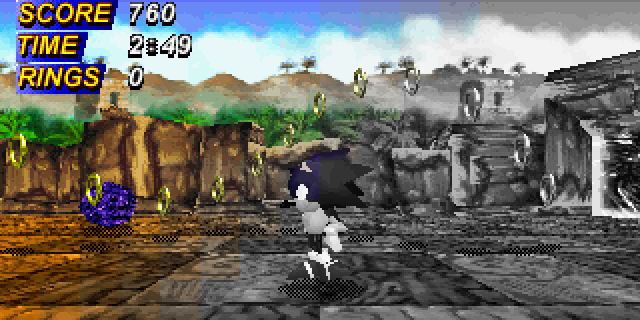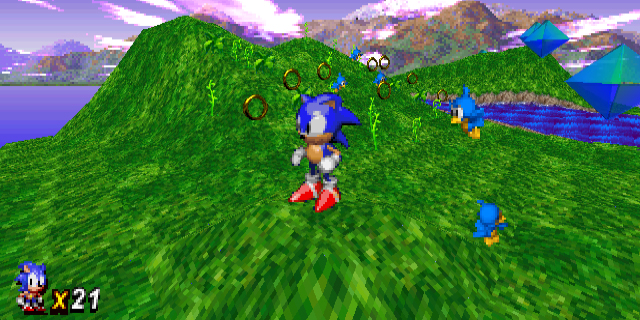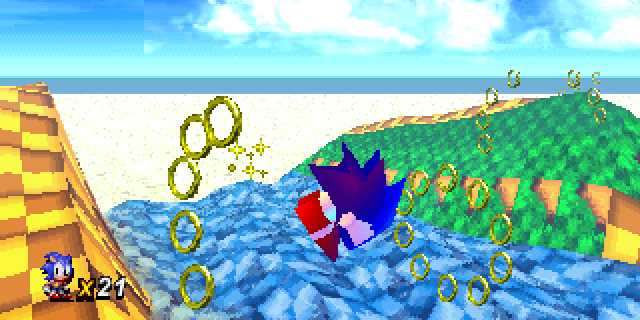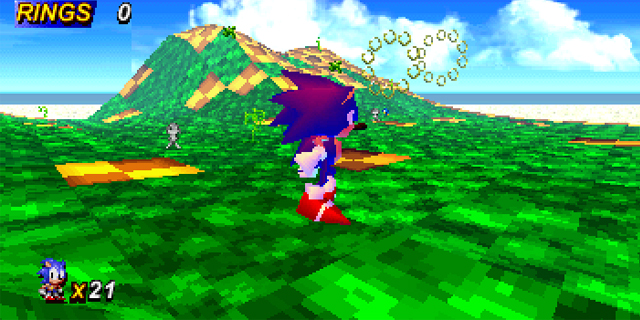
Many retro game fans like to theorize and fantasize about what might have saved Sega. Many say that it was the Sega CD and 32X that undermined consumer confidence in Sega. Others say that it was the PlayStation 2’s unparalleled dominance of the console market that killed the Dreamcast, and by extension, Sega itself. Others even say that it was its lack of effort in the handheld space to keep up with Nintendo’s Game Boy to help stave off defeat during the lean years. One factor that most agree contributed is that Sega didn’t really carry the genres that were popular on the Genesis into the next generation on the Saturn, causing a huge backlash of disinterest outside of Japan.
Sonic X-Treme
What It Was: A 3D Sonic game meant to showcase the 32X, then the Sega Saturn
What Happened: Sega’s American and Japanese divisions feuding caused the game to be scrapped entirely
Why We Wanted It: It would have kindled American interest in the Saturn, possibly giving it a fighting chance
During the 16-bit years, Sega seemed to do everything right in terms of marketing Sonic not only as the mascot of the Genesis, but also as a rival to Nintendo’s throne as the face of gaming. In the West, at least. This was because after getting utterly demolished by Nintendo during the 8-bit era in the states, Sega of Japan allowed Sega of America a great deal of autonomy in business decisions. This autonomy allowed Sega to win over the hearts and wallets of Western gamers, and command a sizeable market share with its 16-bit machine.
Things were going great, even with the somewhat-controversial release of the Sega CD. Then something happened. No one really knows what or when for sure, but most attribute the 32X as the point where things started to go wrong for the company. Both the American and Japanese divisions had prototype hardware ready for the company’s next hardware add-on, codenamed the Sega Mars. Animosity began to grow between the two halves of Sega, as they wasted valuable time arguing about whose hardware was more powerful. In the end, Sega of America was allowed to develop the add-on… without knowledge that Sega was already working on its next-gen console, the Saturn.

The 32X was largely a flop, likely due to pricing and lack of games, and Sega needed a Sonic game to move units fast. While the 32X Sonic game that was ultimately released was Knuckles Chaotix, a retooling of a previously-scrapped Genesis game called Sonic Crackers, there was a true next Sonic game intended for the hardware.
Sonic X-Treme was to be an on-rails 3D platforming game to showcase the system’s processing capabilities, but due to the 32X’s immediate failure, it was pushed ahead to the Sega Saturn. Sega of America promised a next-gen Sonic game on the new console almost from the very launch of its system, and if the promise wasn’t explicit before that, it was certainly implied in the minds of gamers. All previous development was scrapped on the 32X version, so the developers could start anew on the Saturn’s hardware.
Sega Technical Institute took a bold approach to 3D Sonic, opting for spherical levels presented through a fisheye camera lens. This allowed the developers to limit the draw distance needed to show a level, which fit in nicely with the system’s less-than-exemplary 3D capabilities. All levels were presented in this fashion except boss fights, which took place on a conventional 3D plane.

Following the embarrassing failure of the 32X, Sega of America was losing some of the autonomy that allowed it to thrive in Western markets. Sega of Japan, like most Japanese game companies at the time, wanted an iron grip on its foreign divisions, and started to once again exercise its authority. So when Sega Technical Institute brought the prototype of Sonic X-Treme in for approval, Sega’s higher-ups quickly turned it down, citing aesthetic distaste as the main point of contention. It expressed great interest, though, in the more standard 3D of the boss fight segments, and told them to scrap the project and instead focus on making a game based solely around that design.
At this time, a good deal of STI was laid off or moved to other projects, and only a select few remained. To make matters worse, the team was pressured to release a product by Christmas of ‘96 to compete with the other two huge upcoming console mascot platformers: Crash Bandicoot and Super Mario 64. What may have doomed the project once and for all was the illness of the game’s lead engine designer and programmer, Christopher Coffin. His bout with pneumonia caused the project to be indefinitely delayed, forcing the team to drop everything after only finishing work on a barely-functional prototype of the new engine, and focus all efforts on a Saturn port of Sonic 3D Blast.

An original Sonic platformer was never released for the Saturn. The Saturn was all but dead in America, thanks to a lack of developer support and poor localization and marketing decisions, so Sega decided to focus efforts elsewhere. Whatever became of the work put into Sonic X-Treme? It was rumored that some of the developers working on the game that had been laid off or transferred began work on a PC port of the original concept without the blessing of Sega of Japan, but there was never anything to show for it.
Several years ago, a Sega fan happened across what he believed to be a beta disc of the prototype Sonic X-Treme made after the original was scrapped. It was put online for others to look at, and was actually playable on modified retail Saturns. It appeared to have taken design cues liberally from Yuji Naka’s Nights Into Dreams, using what may even be the same engine and some art assets, as evidenced by the floral, undulating ground that looks strikingly similar to that in Nights’ Splash Garden stage.
The absence of a Sonic game on the Saturn was likely one of the big mistakes made with the system; many Sega fans held out on buying a Saturn until a Sonic game was released, and when they never got one, they turned to other systems. While it wasn’t the biggest nail in Sega’s coffin by any stretch of the imagination, it was certainly a notable one, and one of the most disappointing aspects of the Saturn’s life.



















